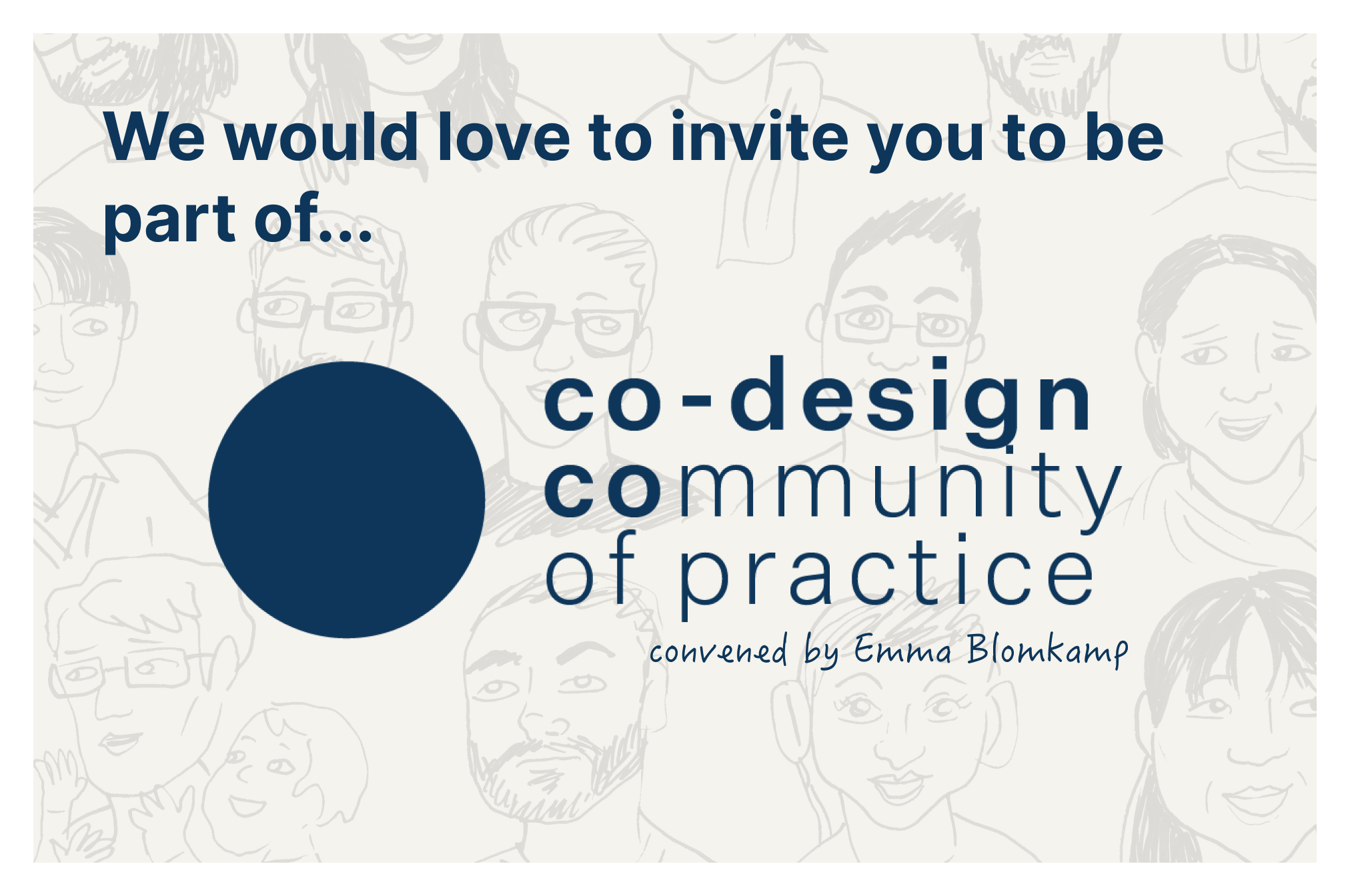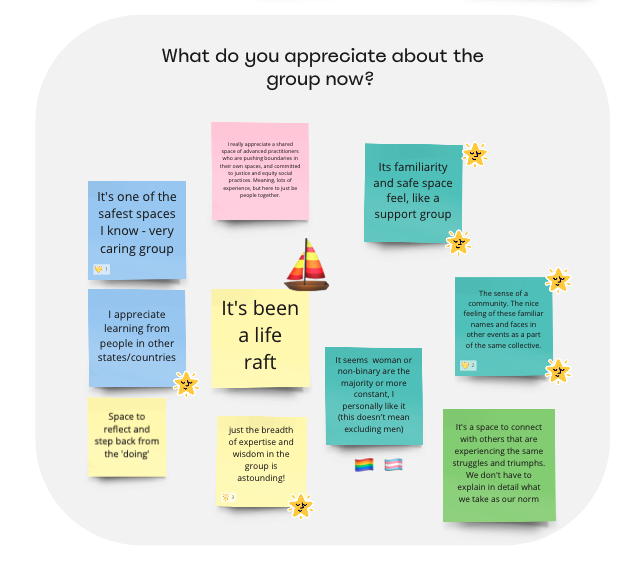Why I’m launching a co-design community of practice
The big, bold new thing I’m doing in 2022 is launching a community of practice for people working to co-create compassionate systems.
The Co-Design Community of Practice (CoDesignCo) is a new online network for changemakers interested in learning and sharing about creative and participatory ways to engage diverse people in our work. We explore how to use co-design and related practices to enhance equity, justice, community wellbeing and regeneration.
Anyone can sign up as a Galah member to access a growing resource bank, bimonthly newsletters and invitations to relevant events. The Kea tier of membership is for more active and involved members to take part in regular events, activities and discussions.
In this post I share about the ideas and experiences that have inspired this new network, and what it offers members.
How CoDesignCo emerged
I’ve been motivated by the way participants in my training programs want to stay connected and keep learning beyond the courses. One of those participants, Marina Moreno, is a driving force behind the community of practice, supporting the establishment and management of the membership.
Co-Design Bootcamp squad 1: class photo from our final session (2021)
CoDesignCo aims to support learning that builds capacity and resilience for systems change. Fiona McKenzie expressed these ideas well in her 2021 report on ‘Building a culture of learning at scale: learning networks for systems change’ [PDF].
My training and coaching programs already focus on supporting continuous cycles of experimental action and critical reflection — as pictured in the iterative learning journey of Co-Design Practitioners. We’re now expanding this with more regular events and communications through CoDesignCo, to scaffold individual, group and systems learning.
Designed to complement other professional activities in which members are engaged, CoDesignCo is intentionally organised around the enabling conditions for flourishing learning networks: mindsets, relationships, processes and structures (McKenzie 2021).
I also learned a lot from co-convening the Co-design Club with KA McKercher. This group of 30 experienced co-design practitioners from Aotearoa and Australia met online throughout 2020 and 2021 to explore topics such as decolonising design and working with lived experience.
In our final sessions, the core members shared appreciation for how the Co-design Club offered mutual caring, learning and sharing. It was a safe space where we didn’t have to explain or justify our practice; we could step back from the ‘doing’, delve into complex topics, build relationships and counsel one another.
Members’ notes of appreciation in a frame from the Miro board created by guest facilitator Nicole Barling-Luke for the final Co-Design Club session (November 2021).
Although many members of the Co-design Club wanted it to continue, they just didn’t have the energy to lead it themselves. And it wasn’t sustainable or appropriate for KA and I to continue indefinitely convening this group for free, without internal or external support.
I get it. Most people who work in this space are pretty stretched as it is, juggling the demands of our employers, clients, colleagues and communities. Not to mention our own health and households. We’re often trying to achieve incredibly ambitious goals in tight timeframes with limited resources. And that’s without being thrown into lockdowns and homeschooling, natural disasters or humanitarian crises. Finding time and space to reflect on your practice is hard enough, without being expected to start volunteering to coordinate or convene peer groups.
What difference I hope this community makes
Starting a new, open community of practice for co-designers and related changemakers seems to fill a gap in the ecosystem. It also aligns with my core goals to build a sustainable business and do work that matters in the long term.
When I talk about work that matters, I mean contributing to and connecting people and practices that result in the following outcomes:
Community members’ voices are heard and the public have input into decisions and actions that affect them. Ultimately this results in more sustainable, equitable and compassionate policies, services and systems.
Public purpose sector professionals and organisations learn more about the people they serve and find better ways to meet their needs, especially by exploring and applying creative and participatory methods of engagement. This also helps to build trust and buy-in with their colleagues, clients/partners and communities.
Designers and changemakers boost their ability to collaborate for social impact. They gain critical awareness and skills in participatory practice and facilitating social change.
The high level of interest in my programs and services tells me there is a desire for all this. Many people in the public purpose sectors are keen to learn about and practise more ethical and effective approaches, yet struggle to find suitably rigorous and accessible training and support on co-design for public and social innovation. There is a lot of confusion and uncertainty out there about what ‘good’ co-design looks like and a huge opportunity for greater sharing among practitioners.
I would love to provide access to relevant knowledge, contacts and resources to a wider range of people, while maintaining a high quality of output and experience. For me, the community membership model represents an exciting opportunity to gain income from providing services such as sharing research on and tools for co-design, strategic design, and public and social innovation. And, to be honest, I hope this helps to avoid low-impact, small-budget, short-sighted contracts.
I’m doing this for myself as well as my community. Because my life and work have been predominantly based in Aotearoa and Australia, that’s where this community of practice is located and focused. This also explains the choice of bird names for the membership tiers!
Being online, CoDesignCo is also open to people from all over the world. We look forward to embracing plurality and diversity in our events and discussions.
As part of my commitment to design justice principles and paying the rent, I’m offering discounted memberships to people from First Nations and lower income countries (contact us for more info).
Because co-design is a relational practice and change is driven through small, committed groups, this community offers opportunities to connect and exchange with others, using creative and participatory methods. We try to practise what we preach! For people who want to co-create more compassionate systems, it’s a way of staying up-to-date on emergent practice, gaining moral support, discovering and trying new tools and techniques, and engaging in reflective dialogue.
If this sounds like something you might appreciate, please join us!
This is an adapted version of a Medium post.



